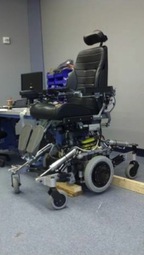Highlight
Development of a Stabilizing and Stair-Climbing Power Wheelchair Controller
Achievement/Results
Standard Electric Powered Wheelchairs (EPWs) have been unable to overcome architectural barriers such as curbs and steep roads. In the past 20 years many models of EPWs have been designed to climb curbs; however, these models show a bigger mechanical design than current EPWs and have other characteristics that might not meet the user’s needs and ISO/RESNA standard wheelchair tests. A novel electric powered wheelchair developed by IGERT fellows, MeBot, has the ability to climb steps and is able to drive under hazardous surfaces, cross slopes, and steep hills. MeBot was designed in consideration of the ISO/RESNA standard wheelchair test and the standard dimensions of current EPWs. In its current form, MeBot is able to climb an 8 inch curb with the use of the switches interface.
Address Goals
The PerMMA project fosters research that will advance the frontiers of knowledge, emphasizing areas of greatest opportunity and potential benefit and establishing the Nation as a global leader in fundamental transformational science and engineering. Algorithmic advances and the social understanding of how technology like PerMMA will be accepted in the community are the project’s greatest contributions. The newest features including the stabilizing and stair cllimbing features are unparalleled in wheelchair robotics. The PerMMA project is also a platform for learning, assisting in NSF’s goal to cultivate a world-class, broadly inclusive science and engineering workforce and expand the scientific literacy of all citizens. Both IGERT fellows on this project, Mr. Candiotti, a first generation Latino student, and Ms. Houston, an individual with mobility impairments, are from underrepresented groups in STEM.






